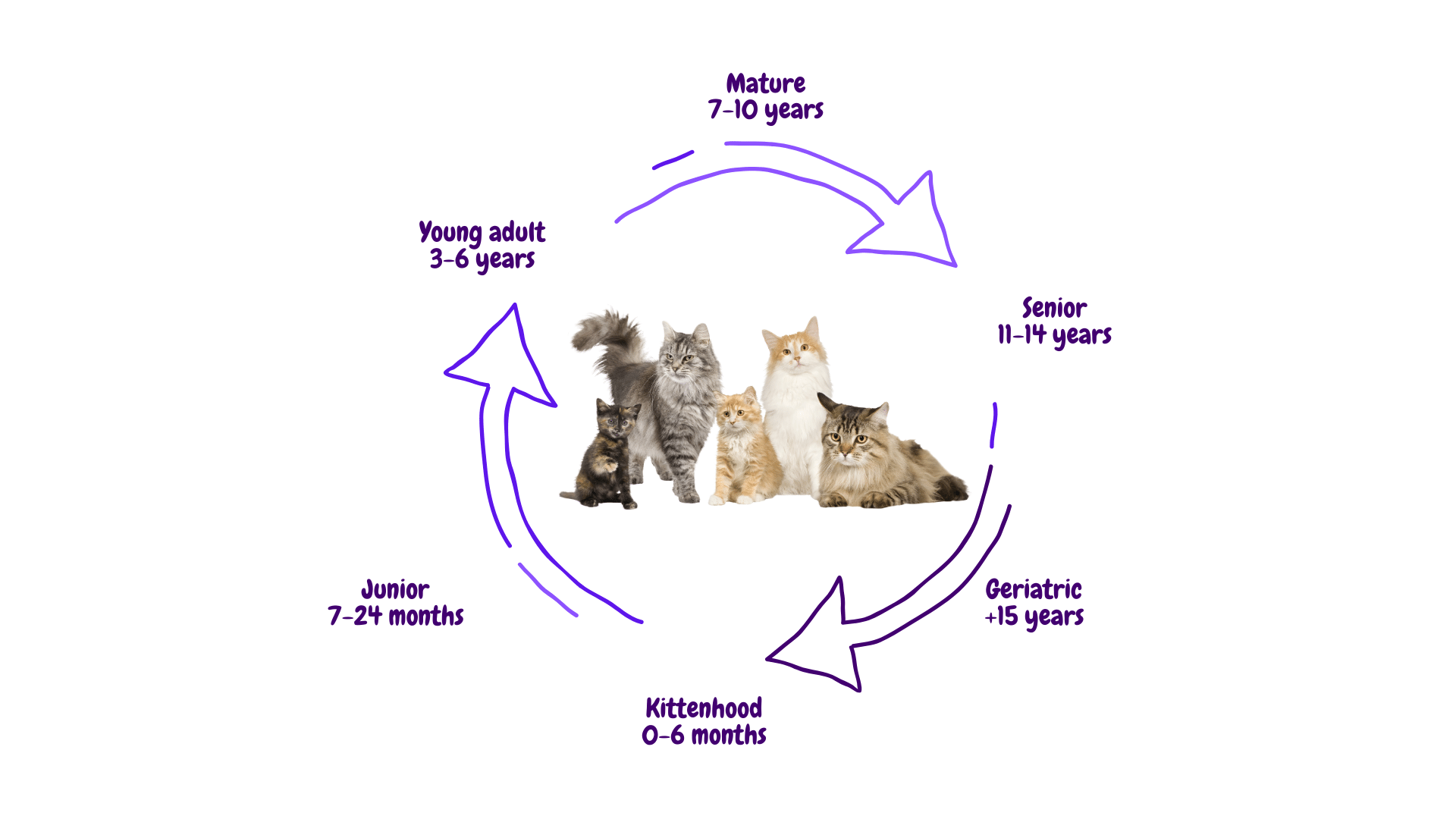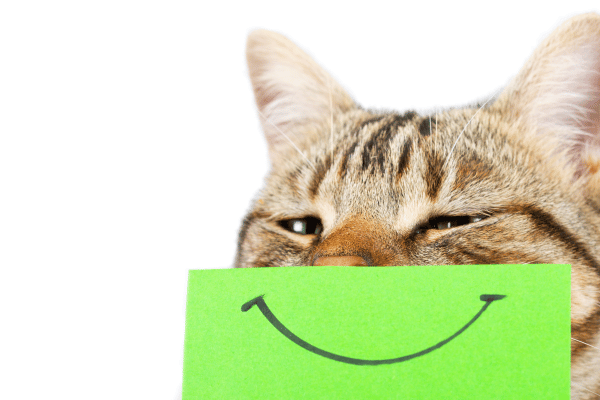Understanding your cat’s life stages is crucial for providing the best care. From their playful kitten years to their more serene senior days, each phase brings unique behaviors and needs. This article delves into these stages, offering insights to help you support your feline friend’s journey.
SubKey Milestones in Cat’s Life

Kittens burst with energy, their days filled with play. This stage is vital for development, both physically and socially. As they grow, you’ll notice changes. Initially, they may be all about exploration and mischief. However, this gradually shifts as they mature. It’s fascinating to observe.
Entering adulthood, cats often maintain some playfulness but become more composed. They establish routines and show distinct personalities. This period is less about physical growth and more about deepening bonds with their humans. It’s a time to strengthen your connection through interactive play and affection.
Senior cats tend to slow down, seeking comfort over adventure. Their needs evolve, requiring more attention to health and comfort. It’s essential to adapt their environment and care to maintain their quality of life. Regular vet visits become increasingly important during this stage.
SubAdapting to Your Cat’s Senior Years
As cats enter their senior years, their pace of life noticeably changes. They might seek out quieter spots, favoring rest over play. This doesn’t mean they lose interest in interaction; rather, they appreciate gentler engagements. Observing these shifts in preference is key to adapting their surroundings for comfort.
Health considerations become more prominent in this life stage. Issues like joint stiffness or dental problems may arise, affecting their daily activities. Providing easy access to cozy resting areas and monitoring their health closely can make a significant difference. It’s about ensuring their golden years are as comfortable as possible.
Nutrition also plays a crucial role during this time. Senior cats have different dietary needs, often requiring food that’s easier to digest and supports joint health. Consulting with a vet to tailor their diet can help maintain their well-being, keeping them healthy and content in their later years.
SubEmbracing Each Moment of Cat’s Life Stages
Every cat’s journey from playful kitten to serene senior is unique. Embracing each moment of these stages enriches our lives and deepens the bond we share. It’s about more than just care; it’s about celebrating the quirks and qualities that make each cat special.
As they age, some cats may develop a more contemplative demeanor, often found basking in the sun or quietly observing their surroundings. This shift towards a peaceful existence is a natural progression, reflecting the depth of their life experiences. It’s a phase to be cherished and respected.
Ultimately, understanding and adapting to your cat’s changing needs through their life stages is a testament to the enduring love and commitment of pet ownership. By providing the right support, environment, and care, we can ensure that every stage of their life is as fulfilling and joyful as possible.
SubEnhancing Comfort in Your Cat’s Golden Years
In the golden years of a cat’s life, comfort becomes paramount. This stage often brings a more sedentary lifestyle, with long hours spent lounging in their favorite spots. As caregivers, it’s our duty to ensure these areas are as cozy and accessible as possible. Investing in orthopedic beds or heated pads can provide relief from joint pain, making their rest more comfortable. Additionally, keeping these areas quiet and away from the hustle and bustle of the household helps in maintaining their peace.
Adapting your home to better suit an aging cat is also crucial. This might include installing ramps or steps to help them reach elevated areas without strain, or placing litter boxes and food dishes on accessible levels to avoid discomfort. Regular grooming becomes increasingly important, as older cats may struggle with self-maintenance. Assisting them with gentle brushing can not only help in keeping their coat healthy but also serve as a soothing bonding activity.
Monitoring health is vital during this life stage. Regular veterinary check-ups can catch potential issues early, ensuring your cat maintains the best quality of life possible. It’s also important to be observant of any changes in behavior, appetite, or activity levels, as these can be early indicators of health concerns. Providing a serene and supportive environment, coupled with attentive care, can make a significant difference in the well-being of senior cats.
SubFostering a Stimulating Environment

Even as cats age, maintaining a stimulating environment is key to their well-being. While senior cats may not engage in vigorous play like they once did, they still benefit from activities that keep their minds sharp and bodies gently active. Introducing puzzle feeders or slow dispensers can turn mealtime into an engaging activity, encouraging them to think and move. This not only enriches their daily routine but also helps in managing their weight by slowing down their eating pace.
Creating safe, accessible spaces for exploration can also contribute to their quality of life. This might involve setting up cozy nooks by windows where they can bask in the sunlight and watch the world go by, or providing shelves and perches that are easy to climb. These small adjustments ensure that they can still satisfy their natural curiosity and desire for elevated viewpoints, without the risk of injury from jumping or climbing too high.
Interaction remains a crucial aspect of their daily life, fostering both mental and emotional health. Simple, gentle games that encourage light movement and mental engagement can be beneficial. Feather wands or laser pointers can be used in a controlled manner to encourage short bursts of activity. It’s important to tailor these interactions to their current physical capabilities, ensuring that play remains a source of joy and not stress.
SubNurturing Your Cat’s Social Needs
Cats, despite their reputation for independence, have significant social needs that evolve throughout their life stages. In their senior years, while they may not seek as much active play, the need for companionship and social interaction remains. It’s crucial to spend quality time with them, engaging in gentle petting sessions or simply sitting together in a quiet room. These moments of quiet companionship can greatly enhance their sense of security and well-being, reinforcing the bond between pet and owner.
For households with multiple pets, it’s important to monitor the dynamics between animals, especially as one ages. Older cats may become less tolerant of younger, more energetic companions. Ensuring that your senior cat has a safe, peaceful space to retreat to can prevent stress and maintain harmony within the home. Introducing new pets gradually and with careful supervision can help in fostering positive interactions and respecting the established territories and preferences of your senior cat.
Socialization extends beyond the immediate household. Familiarizing your cat with different people and environments can contribute to their adaptability and reduce anxiety in potentially stressful situations, such as vet visits. Short, positive experiences with visitors or in new settings can help maintain their social skills and confidence, even as they age. Balancing their need for peace with gentle social stimulation can keep them engaged and content through their golden years.
SubPrioritizing Preventive Health Care
Preventive health care becomes increasingly critical as cats progress through their life stages, particularly in their senior years. Regular veterinary check-ups are essential for early detection and management of age-related conditions such as kidney disease, arthritis, or dental issues. These visits should include comprehensive exams that assess everything from dental health to organ function, ensuring any potential problems are identified and addressed promptly. Tailoring vaccinations and parasite control to their current health status and lifestyle is also crucial, as their immune system may not be as robust as it once was.
Diet plays a pivotal role in preventive health care. As cats age, their nutritional needs change, and their diet may need adjustment to support their metabolism, organ function, and overall health. High-quality, age-appropriate food that is rich in essential nutrients can help maintain their health and vitality. Consulting with a veterinarian to choose the best diet plan can ensure that your cat receives the right balance of nutrients to support their well-being at this stage of life.
Mental health is just as important as physical health, especially for aging cats. Keeping their mind engaged through interactive toys, puzzle feeders, or simple training exercises can help prevent cognitive decline and keep them mentally sharp. Providing a safe, enriching environment that stimulates their senses can contribute significantly to their quality of life, helping to maintain their cognitive abilities and overall happiness as they age.
SubUnderstanding Behavioral Changes in Aging Cats
As cats age, they may exhibit behavioral changes that can be perplexing to their owners. Recognizing these changes as part of the natural aging process is crucial. For instance, senior cats might vocalize more, either due to confusion, discomfort, or a need for reassurance. Providing a calm and stable environment, along with gentle reassurance, can help alleviate their anxiety. It’s also important to consider that increased vocalization could be a sign of underlying health issues, warranting a veterinary consultation.
Changes in sleep patterns are also common in older cats. They may sleep more during the day and become more restless at night. This shift can be attributed to various factors, including changes in their circadian rhythm or discomfort due to health issues. Creating a comfortable sleeping area that’s easily accessible can help improve their rest. If nighttime restlessness persists, it’s advisable to consult with a veterinarian to rule out any medical concerns.
Litter box habits may also change with age. Issues such as arthritis can make accessing a litter box with high sides challenging. Switching to a box with lower sides and placing it in an easily accessible location can greatly assist your aging cat. Additionally, any deviation from normal litter box use should prompt a veterinary check-up, as it could indicate a health problem. Understanding and accommodating these behavioral changes with patience and care can significantly enhance the quality of life for aging cats.
SubEmphasizing the Importance of Hydration
Hydration is a critical aspect of health for cats at any age, but it becomes even more essential as they grow older. Senior cats are particularly susceptible to renal issues, making adequate water intake vital to support kidney function. Encouraging them to drink can sometimes be challenging, but there are effective strategies to promote hydration. Offering fresh water in multiple locations around the home ensures that a drink is never too far away. Additionally, many cats prefer running water; thus, investing in a cat water fountain can stimulate their interest in drinking more frequently.
Incorporating wet food into their diet is another way to increase water intake. Wet food has a higher moisture content compared to dry kibble, which can significantly contribute to their daily water consumption. This is particularly beneficial for cats that are reluctant to drink enough water on their own. It’s also worth noting that the palatability of wet food can be higher for many cats, which can help maintain appetite in senior felines who may be more finicky about their food.
Observing your cat’s hydration habits is important, as changes can indicate health issues. Signs of dehydration, such as lethargy, dry gums, or decreased skin elasticity, require immediate veterinary attention. Regularly cleaning and refilling water bowls can also encourage more frequent drinking. By understanding the importance of hydration and taking proactive steps to ensure your cat is drinking enough, you can support their overall health and well-being as they age.
SubCreating a Safe and Accessible Home

As cats move through different life stages, particularly into their senior years, their mobility and agility can decline. This necessitates adjustments in the home to maintain their safety and comfort. Simple modifications, such as providing step stools or ramps to their favorite elevated spots, can make a significant difference. These aids help them continue to enjoy their preferred perches without the risk of injury from jumping. Ensuring that these areas are secure and stable is also crucial to prevent falls.
Flooring is another important consideration. Slippery surfaces can pose a challenge to older cats, especially those with joint issues like arthritis. Placing non-slip mats or rugs in areas where they frequently walk or jump can provide them with the extra traction needed to move confidently. This can help prevent slips and falls, reducing the risk of injury. Additionally, keeping walkways clear of clutter ensures that they have a safe path to navigate through the home.
The placement of essential resources such as food, water, and litter boxes should also be re-evaluated. These should be easily accessible, requiring minimal effort to use. For example, placing litter boxes on every floor of a multi-story home can prevent the need for your cat to navigate stairs frequently. Making these thoughtful adjustments in your home can greatly enhance the quality of life for your aging feline friend, ensuring their comfort and safety in their familiar environment.
Conclusion: Nurturing Your Cat Through Every Stage
Navigating your cat’s life stages from playful kittenhood to serene senior years offers a unique blend of challenges and joys. Understanding and adapting to each phase enriches the bond between you and your feline friend. It’s a journey that requires compassion, knowledge, and a willingness to adjust care practices as your cat’s needs evolve.
As cats transition into their golden years, our role in their lives becomes increasingly vital. We must remain attentive to changes in their health, comfort, and overall well-being. This includes regular veterinary check-ups, dietary adjustments, and ensuring their living environment supports their changing needs. Creating a stimulating yet safe space for them to explore and rest is crucial for maintaining their quality of life.
Cherishing each moment with our cats means embracing every stage with love and understanding. For further guidance on caring for your cat through all stages of their life, consider visiting The American Association of Feline Practitioners for expert advice and resources. Sharing your experiences and tips in the comments can also help build a supportive community of cat lovers. Let’s continue to learn and grow together in our journey of feline care.
III. Frequently asked questions about pet life stages
- Is it safe to feed dog food to a cat or vice versa?It is not recommended to feed dog food to a cat or vice versa, as each type of food is formulated to meet the specific nutritional needs of each species.
- How can you calculate a dog or cat's "human age"?A dog or cat's "human age" can be calculated using specific formulas that consider the pet's size and actual age, but these formulas are only estimates.
- What are the benefits of genetic testing for pets?Genetic testing can offer insights into disease predisposition, breed characteristics, and guide the most appropriate care and management for the pet's health.
- How can you identify and prevent joint diseases in pets?Joint diseases can be identified by signs such as movement difficulty, pain when touched on the joints, and reluctance to jump or play. Prevention includes maintaining an ideal weight, regular exercise, and supplementation if necessary.
- How has the life expectancy of pets changed in recent decades?The life expectancy of pets has increased due to advancements in veterinary medicine, nutrition, and greater awareness of preventive care and animal welfare.
- What veterinary tips are essential for feeding pets at each life stage?Tips include providing a balanced diet suitable for the life stage, considering special health needs, and adjusting portions to prevent overweight.
- How can proper nutrition influence the effectiveness of vaccines in puppies?Balanced and nutrient-rich nutrition can strengthen the immune system of puppies, enhancing their response to vaccines.
- How can you determine a cat's age in human years?A cat's age in human years can be estimated by considering that the first two years correspond to about 24 human years, with each subsequent year equating to approximately four human years.
- What are the signs that your dog is aging?Signs include decreased energy, the appearance of white hair, movement difficulty, behavioral changes, and possible age-related health issues.
- What is the ideal toy for each stage of a dog's life?Puppies may benefit from teething toys, adult dogs may need durable chewing toys and interactive toys for mental stimulation, and senior dogs may prefer softer, easy-to-handle toys.
- Toggle TitleToggle Content

Join Marjorie Pearson at dwfocus.com, your guide in the pet parenting world. As an experienced animal behaviorist, Marjorie offers heartfelt advice for pet owners. Her expertise spans from nurturing kittens to understanding dogs’ playful antics. She’s passionate about enhancing the bond between pets and their humans through understanding and empathy. Discover Marjorie’s practical training tips and insights on dwfocus.com, enriching your journey as a pet owner. #4PawsAndOwners #MarjorieEarsonPetWhisperer #dwfocus







